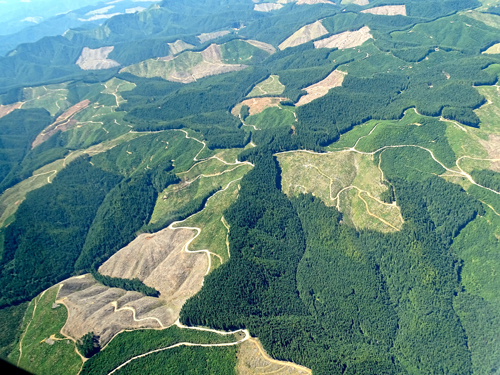A network of unpaved roads crisscrosses America’s forests and national parks, cutting through the trees. Rain, a lack of plant roots to hold soil in place, and the pressure of cars or trucks on roads can accelerate erosion and wash dirt into watersheds where rare fish breed. This dirt can smother fish eggs, preventing them from hatching.

According to a 2010 U.S. Fish and Wildlife Service report, “Excessive sedimentation…is considered the most important factor limiting fish habitat and causing water quality impairment.” Given that, as of 2012, more than 2 million kilometers of unpaved roads ran over the U.S. countryside, the impact of these roads on wildlife may be substantial.
This leaves park managers and conservationists with a quandary. Will closing a road necessarily keep streams from clogging with dirt? And what should be done about roads that can’t be closed because they are needed by those who live and work in rural areas? The difficulties of balancing human access to forests with efforts to preserve wildlife has led to Supreme Court decisions and fights over the well-being of towns.
In a new paper in Restoration Ecology, a group of scientists examined how dirt roads affect watersheds. They concluded that although closing dirt roads does improve local streambed quality, there is, as yet, no easy policy solution.
Risks to Breeding Grounds
Prior research has shown that too much fine sediment in a stream can make it inhospitable to both fish and the invertebrates that they feed on. Bull trout, for example, bury their eggs in sturdy gravel nests for protection.
If the stream bottom is covered in dense silt, eggs won’t get enough oxygen from the flowing water, and the hatchlings inside will suffocate.
“The female will dig with her tail—it’s pretty remarkable,” says Robert Al-Chokhachy, a fish biologist with the U.S. Geological Survey in Bozeman, Mont., and lead author on the study. However, if the stream bottom is covered in dense silt because of runoff from nearby roads, Al-Chokhachy said, the eggs won’t get enough oxygen from the flowing water, and the hatchlings inside will suffocate.
“It’d be the same as you in an avalanche, except that would be faster,” said Robert Hughes, a retired regional aquatic ecologist with the Amnis Opes Institute in Bend, Ore., who was not involved with the study.
Balancing Protection with Human Needs

Throughout the Pacific Northwest, populations of salmon and other fish face similar hazards. Six different salmonid species are listed as threatened or endangered under the U.S. Endangered Species Act, driving conservation efforts. Conservationists sometimes also use the Clean Water Act to try to force logging companies and communities to close dirt roads.
However, shutting down roads isn’t always a good option. As the study’s authors point out, unpaved roads can provide critical access to local residents, businesses, and emergency services.
“The number of roads on public land is unbelievably high,” said Al-Chokhachy, “so if you’re going to think about what roads to remove, you can’t just act blindly.” Moreover, road closure and subsequent restoration efforts to both the roadbed and the stream can be expensive—sometimes with little impact on species diversity, according to prior research.
What Makes a Watershed Vulnerable?
Al-Chokhachy and his team sought to pinpoint what makes a road particularly bad for watersheds. Over the course of 4 years, they measured the sediment runoff from roads at a field site in the mountains of western Montana where the U.S. Forest Service studies different conservation strategies. The scientists examined the volumes of gullies along the sides of roads, measured surface erosion rates, and caught runoff water to measure the amounts of sediment it was carrying.
The amount of sediment washed off of different roads varied by more than an order of magnitude. The scientists found that crossings between roads and streams—culverts and similar intersections—produced the most silty runoff. As expected, fewer roads resulted in less sediment in the streams.
A Fuzzy Understanding
Ultimately, the team’s results could not produce a broad policy recommendation that would aid fish without inconveniencing humans.
The team’s results highlight an important problem in conservation: a lack of sufficient research before policy makers embark on restoration projects.
However, Al-Chokhachy said that the variety of the team’s results highlights an important problem in conservation: a lack of sufficient research before policy makers embark on restoration projects.
What’s more, restoration projects don’t always follow through on how the efforts have helped ecosystem health. “I think when we do any kind of mitigation, rehabilitation, or naturalization of systems, we should do some before and after studies and learn from these projects,” Hughes said. “We’ve spent billions of dollars [on stream rehabilitation, dam removal, and other projects] and not done that, so we don’t know the effects of our actions.”
Too often, Al-Chokhachy said, road closings only succeed in angering local residents who used those roads, whereas the closing’s impact on wildlife remains unknown. “In most cases, if you did a study and looked at potential hot spots and addressed those, you’d have much more effective restoration, much less public pushback, and much more cost-effective use of public dollars,” Al-Chokhachy concluded.
—Elizabeth Deatrick, Writer Intern; email: [email protected]
Citation:
Deatrick, E. (2016), Silty streams muddy freshwater conservation issues, Eos, 97, https://doi.org/10.1029/2016EO054243. Published on 15 June 2016.
Text © 2016. The authors. CC BY-NC-ND 3.0
Except where otherwise noted, images are subject to copyright. Any reuse without express permission from the copyright owner is prohibited.

